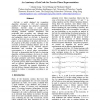Free Online Productivity Tools
i2Speak
i2Symbol
i2OCR
iTex2Img
iWeb2Print
iWeb2Shot
i2Type
iPdf2Split
iPdf2Merge
i2Bopomofo
i2Arabic
i2Style
i2Image
i2PDF
iLatex2Rtf
Sci2ools
63
Voted
ICPR
2006
IEEE
2006
IEEE
An Anatomy of IrisCode for Precise Phase Representation
IrisCode, a widely deployed iris recognition algorithm, developed in 1993 and continuously modified by Daugman has attracted considerable attentions. IrisCode using a coarse phase representation has number of properties such as rapid matching, binomial imposter distribution and predictable false acceptance rate. Although many similar coding methods have been developed for irises and palmprints based on IrisCode, a theoretical analysis of IrisCode has not been provided. In this paper, we aim at studying (1) the nature of IrisCode, (2) the property of the phase of Gabor function, (3) the extension of bitwise hamming distance and (4) the theoretical foundation of the binomial imposter distribution and extending the coarse phase representation to a precise phase representation. Precisely, we demonstrate that IrisCode is a clustering algorithm with four prototypes; the locus of a Gabor function is a two-dimensional ellipse with respect to the phase parameter and bitwise hamming can be rega...
Binomial Imposter Distribution | Coarse Phase Representation | Computer Vision | ICPR 2006 | Precise Phase Representation |
| Added | 09 Nov 2009 |
| Updated | 09 Nov 2009 |
| Type | Conference |
| Year | 2006 |
| Where | ICPR |
| Authors | Adams Wai-Kin Kong, David Zhang, Mohamed Kamel |
Comments (0)

